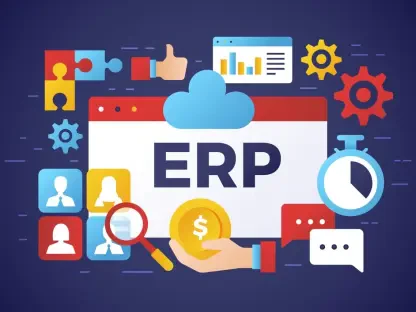Setting the Stage for SaaS Data Protection
In an era where enterprises rely on an ever-expanding array of Software as a Service (SaaS) applications, a staggering 94% of organizations have reported experiencing outages in their SaaS environments, according to a recent industry report by Veeam. This alarming statistic underscores a critical vulnerability in modern business operations, where data loss from outages, ransomware, or vendor lock-in can cripple productivity and erode trust. As companies juggle thousands of SaaS tools annually, the challenge of safeguarding critical data has never been more pressing, paving the way for innovative solutions to step into the breach.
The spotlight falls on AI-driven automation as a transformative force in addressing these risks. By harnessing artificial intelligence, backup solutions are evolving to keep pace with the rapid proliferation of SaaS platforms, offering a lifeline to enterprises struggling with manual, time-intensive data protection methods. This review delves into the pioneering approach of Keepit, a Danish cloud data protection company, which leverages AI to redefine how SaaS backups are managed and scaled for enterprise needs.
Unpacking Keepit’s AI-Powered Backup Technology
Revolutionizing Connector Development with AI
At the heart of Keepit’s strategy lies its use of AI to automate the creation of connectors for SaaS applications. This technology analyzes application programming interfaces (APIs), schemas, and documentation to generate connector code, slashing the time and effort traditionally required for manual development. The ambition is clear: scaling from a modest base of seven connectors in the current year to hundreds by 2028, ensuring coverage for a vast array of platforms that businesses rely on daily.
This AI-driven approach offers a stark contrast to conventional coding practices, accelerating development speed by orders of magnitude. For enterprises, this means faster integration of backup solutions for new SaaS tools as they emerge, reducing the window of vulnerability. The potential to protect data across diverse ecosystems positions this technology as a game-changer in a landscape where agility is paramount.
Vendor-Independent Infrastructure for Enhanced Control
Beyond connector automation, Keepit distinguishes itself with a self-hosted infrastructure model, operating through private data centers rather than relying on public cloud providers. This vendor-independent stance prioritizes data sovereignty, ensuring that enterprises maintain control over their information in an age of stringent regulatory demands. Security is further bolstered by immutable, air-gapped backups and blockchain technology for integrity verification.
This infrastructure choice enhances performance, catering to enterprise needs for rapid data access and recovery. Unlike competitors tethered to public cloud ecosystems, Keepit’s model offers a tailored approach that mitigates risks associated with third-party dependencies. The result is a robust foundation for data protection that aligns with the growing emphasis on autonomy and resilience in corporate IT strategies.
Performance and Real-World Applications
Protecting Data Across Major SaaS Platforms
Keepit’s technology demonstrates its prowess by safeguarding data across widely used SaaS platforms such as Microsoft 365, Google Workspace, Salesforce, Atlassian, and Okta. This broad compatibility ensures that enterprises can protect critical workflows, from collaboration tools to customer relationship management systems, under a unified backup framework. The ability to cover such a diverse range of applications speaks to the adaptability of the AI-driven system.
Specific use cases highlight the practical impact of this solution. Rapid restores enable businesses to minimize downtime during data loss incidents, while intelligent automation optimizes recovery point objectives (RPOs) and recovery time objectives (RTOs). These features translate into tangible benefits, allowing companies to meet tight operational deadlines and maintain continuity even under duress.
Industry-Wide Implications for Business Continuity
The broader implications of Keepit’s technology extend to industries heavily dependent on SaaS tools, such as finance, healthcare, and technology. By providing a safeguard against data loss, the solution helps mitigate the cascading effects of outages or cyberattacks that could disrupt entire sectors. This protective layer fosters confidence in digital transformation initiatives, encouraging adoption of cloud-based tools without the looming fear of unrecoverable data.
Moreover, the competitive landscape reveals a growing trend toward comprehensive backup solutions. As rivals like HYCU push boundaries with their own AI-driven efforts, Keepit’s focus on scalability and performance positions it as a strong contender. The ripple effect is a heightened industry standard, where data protection becomes a non-negotiable priority for enterprises navigating cyber threats.
Challenges in Scaling AI-Driven Backup Solutions
Navigating Risks in Automated Connector Development
Despite its promise, AI-driven connector development is not without hurdles. Potential errors or inaccuracies in generated code, often referred to as “hallucinations,” pose risks to reliability. Additionally, the constant evolution of SaaS APIs demands ongoing updates to maintain compatibility, creating a moving target for automation engines that must adapt swiftly to avoid gaps in coverage.
Keepit addresses these challenges through human oversight and rigorous testing protocols, ensuring that AI outputs meet stringent quality standards. Learning from the experiences of competitors like HYCU, the company refines its processes to balance speed with precision. This cautious approach is essential to building trust among enterprises wary of untested automation in high-stakes environments.
Market and Technical Barriers to Adoption
Beyond technical risks, market barriers also loom large. The complexity of maintaining quality at scale, especially as the number of connectors grows, could strain resources and impact consistency. Enterprises may hesitate to adopt such solutions if integration proves cumbersome or if costs outweigh perceived benefits, particularly for smaller organizations with limited budgets.
Technical barriers further complicate widespread adoption. Ensuring seamless performance across diverse SaaS environments requires continuous investment in infrastructure and AI refinement. While Keepit’s self-hosted model offers advantages, it must contend with the challenge of matching the global reach and familiarity of public cloud alternatives, a factor that could influence customer decisions in a crowded market.
Looking Ahead: The Future of SaaS Data Protection
Scaling Innovations and Industry Impact
The trajectory of AI in SaaS backup automation points toward significant advancements, with Keepit’s roadmap signaling a relentless push for connector scalability. The goal of covering hundreds of applications by 2028 reflects an intent to stay ahead of SaaS proliferation, ensuring that no enterprise data source remains unprotected. Potential breakthroughs in AI algorithms could further streamline development, reducing errors and enhancing adaptability.
Long-term implications for enterprise data protection are profound. As SaaS adoption continues to surge, solutions like Keepit’s could become the backbone of corporate IT strategies, embedding resilience into the fabric of digital operations. The shift toward automation also pressures SaaS providers to elevate their native backup offerings, fostering a more secure ecosystem overall.
Reshaping the Competitive Landscape
Advancements in AI and infrastructure are poised to redefine industry dynamics, positioning companies with robust automation and independent models as market leaders. Keepit’s commitment to private data centers and data sovereignty aligns with emerging regulatory trends, potentially giving it an edge over competitors reliant on public cloud frameworks. This strategic focus could influence how enterprises evaluate backup vendors in the coming years.
The broader industry may see a convergence of AI-driven innovation and customer-centric design, where ease of use and reliability become key differentiators. As cyber threats evolve, the ability to deliver rapid, accurate recovery will likely separate frontrunners from laggards. Keepit’s ongoing investment in research and development suggests a readiness to lead this charge, shaping the future of data protection.
Final Thoughts on Keepit’s Technological Stride
Reflecting on this evaluation, Keepit’s AI-driven approach to SaaS backup automation stands out as a bold step forward in tackling the vulnerabilities of modern enterprise data environments. Its blend of connector scalability and self-hosted infrastructure delivers a compelling case for enhanced control and security, addressing real-world challenges faced by businesses. The technology’s performance in safeguarding major SaaS platforms underscores its relevance in a landscape fraught with cyber risks.
Looking back, the journey reveals areas for refinement, particularly in mitigating AI errors and overcoming adoption barriers. Yet, the potential for growth is evident, with a clear roadmap that promises to expand coverage and refine capabilities. For enterprises seeking to fortify their data protection strategies, exploring solutions like Keepit’s offers a proactive path to resilience.
Moving forward, the focus should shift to fostering collaboration between backup providers and SaaS vendors to create integrated, seamless protection frameworks. Enterprises are encouraged to assess their backup needs critically, prioritizing solutions that balance automation with reliability. As the industry evolves, staying ahead of emerging threats through continuous innovation remains the ultimate imperative for safeguarding digital assets.









